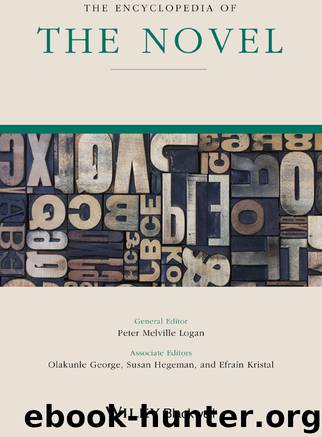The Encyclopedia of the Novel by unknow

Author:unknow
Language: eng
Format: epub
ISBN: 9781405161848
Publisher: Wiley
Published: 2011-01-18T00:00:00+00:00
The Postwar Jewish American Novel
The period from WWII to the early 1970s marks another phase of the Jewish American novel. Showcasing humor, (male) libido, and the major literary awards, this is often called the Golden Age of Jewish American literature. Mark Shechner labels the novels of this period allegories of loss that, by a strange logic, grant their writers a ticket to the American heartland. The keynotes in the 1940s and 1950s are crisis and conversion: the American Jew can no longer be the person s/he was (Shechner 1990). Not only does the Dostoyevskian alienation of Rosenfeld and early Bellow show the economic and political concerns of the 1930s in decline, but in the writing of Norman Mailer, for example, as in Bellow's novels of the 1950s, including The Adventures of Augie March (1953)—which, opening with “I am an American, Chicago born,” is often cited as a key turning point when the Jewish American novel enters the mainstream of U.S. literature—Seize the Day (1956), and Henderson the Rain King (1959), the ideologies of the fathers are traded in for the therapeutic replacements of antic rage and psychosexual liberation. But there's still another way this literature suggests change, in many ways more significant, and problematic, for the history of the Jewish American novel. In the early novels of Bernard Malamud, like The Assistant (1957) and A New Life (1961), characters born into Jewish milieus no longer inhabit a determinably Jewish orbit; his first novel, The Natural (1952), lacks any explicit Jewish content. A major theme of Philip Roth's early novels, like Goodbye, Columbus (1959), Letting Go (1962), My Life as a Man (1964), and Portnoy's Complaint (1969), is a decreasingly persuasive Jewish tradition. If Malamud was later to say (famously) that “Every man is a Jew though he may not know it” (Lasher, 30), the price of universality may be the disappearance of self-evident Jewish experience. Jewish novelists after the war are not only ex-immigrants and ex-Trotskyists: increasingly, as they enter the American middle class, leaving the city for the suburbs, Jews are becoming ex-Jews, too. In the avant-naturalism of Mailer, Bellow, Malamud, and Roth, Jewish tradition seems to be decomposing. In fact, this literature of loss is really a literature of “departure” (Schwartz's word): the postwar Jewish American novel of crisis chronicles an alienation that is catalytically productive: of a new kind of Jewish American as much as of a newly national literature.
But while the persuasive power of Jewish tradition decayed between WWII and the Vietnam War (1954–75), the Jewish American novel of the period also highlights a Jewish self that does not fully accede to the terms of a dominant Americanism. After 1948 and especially 1967, Israel, like the Holocaust, proves that Jews, whatever else one might say, exist, and in the 1960s and 1970s, we see a kind of return of the repressed as assimilated Jews rediscover an incompletely suppressed Jewishness. Race becomes a major theme, as black power, civil rights, and ethnic identity movements offer new ways of focusing the problematic of Jewish American identity.
Download
This site does not store any files on its server. We only index and link to content provided by other sites. Please contact the content providers to delete copyright contents if any and email us, we'll remove relevant links or contents immediately.
Aircraft Design of WWII: A Sketchbook by Lockheed Aircraft Corporation(32212)
The Great Music City by Andrea Baker(31340)
Call Me by Your Name by André Aciman(20371)
The Secret History by Donna Tartt(18843)
The Art of Boudoir Photography: How to Create Stunning Photographs of Women by Christa Meola(18537)
Shoot Sexy by Ryan Armbrust(17655)
Plagued by Fire by Paul Hendrickson(17330)
Portrait Mastery in Black & White: Learn the Signature Style of a Legendary Photographer by Tim Kelly(16952)
Adobe Camera Raw For Digital Photographers Only by Rob Sheppard(16904)
Photographically Speaking: A Deeper Look at Creating Stronger Images (Eva Spring's Library) by David duChemin(16622)
Ready Player One by Cline Ernest(14523)
Pimp by Iceberg Slim(14393)
Bombshells: Glamour Girls of a Lifetime by Sullivan Steve(13972)
The Goal (Off-Campus #4) by Elle Kennedy(13542)
Art Nude Photography Explained: How to Photograph and Understand Great Art Nude Images by Simon Walden(12975)
Kathy Andrews Collection by Kathy Andrews(11728)
The Priory of the Orange Tree by Samantha Shannon(8890)
The remains of the day by Kazuo Ishiguro(8819)
Thirteen Reasons Why by Jay Asher(8792)
